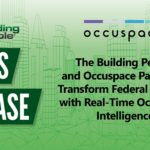Making Federal Buildings and Facilities Work Smarter
Under the direction of the 2025 Trump administration, federal agencies face a renewed mandate to cut costs, consolidate space, and boost productivity. With new executive orders emphasizing in-person work, streamlined hiring, and drastic reductions in real estate waste, the opportunity is clear: agencies must modernize or risk falling behind. Let’s break down each of these executive orders to see exactly how they impact agencies and what practical steps can be taken to adapt effectively.
Return to In-Person Work: Everyone Back to the Office
The administration’s return-to-office directive mandates that federal employees resume full-time in-person operations, citing the need to restore collaboration, accountability, and mission execution.
The Challenge
Federal buildings designed for pre-pandemic operations are underutilized, with many facilities at 25% occupancy while still incurring full operational costs. Agencies must rapidly adapt their space to accommodate full capacity without expanding square footage.
Practical Ways Agencies Can Adapt:
- Real-Time Occupancy Intelligence: Sensor-driven analytics reveal true space usage and enable data-backed reconfiguration.
- Smart Occupancy Design: Agile workspace designs that align occupancy with mission flow and workforce needs.
- Integrated Facility Management: Vendor-agnostic smart building systems to ensure peak performance and secure integration.
Streamlining the Federal Hiring Process
The administration is cutting red tape and enforcing merit-based, mission-critical hiring practices. Agencies are now expected to hire faster, staff smarter, and justify resource utilization.
The Challenge:
Agencies face rapid workforce fluctuations and an urgent need to match human capital with evolving mission demands—without wasting space or duplicating resources.
Practical Ways Agencies Can Adapt:
- Predictive Modeling: Forecast staffing needs and align facility configurations to scale with growth or contraction.
- Dynamic Office Design: Modular workspaces or flexible seating arrangements that adapt as team sizes fluctuate. A physical space that remains responsive to workforce changes without costly redesigns or disruptions.
- Talent Optimization & Coaching: Implement behavioral science and strategic coaching to help teams adapt and lead through change.
- Integrated Support Services: Workforce transformation programs to improve productivity, retention, and mission alignment.
Shrinking the Footprint: Optimizing Federal Real Estate
The administration’s cost-cutting directive includes aggressive mandates to dispose of excess property, eliminate redundant leases, and digitize paper-heavy operations. The newly established Department of Government Efficiency (DOGE) is charged with enforcing results and delivering measurable savings.
What Does This Mean for Agencies?
Agencies must identify excess space, consolidate operations, and optimize asset performance—with clear data to justify decisions.
Strategies Agencies Can Implement:
- Smart Portfolio Optimization: Integrate AI, IWMS/CMMS systems, and occupancy data to consolidate underused assets and reduce lease obligations.
- Energy & Asset Lifecycle Management: Adopt smart building tech that supports predictive maintenance, energy efficiency, and lifecycle tracking.
- Digital Facilities Strategy: Automate workflows and digitize asset data to help agencies streamline operations and accelerate DOGE compliance.
Department of Government Efficiency (DOGE): Streamlining Operations and Reducing Waste
With the launch of the Department of Government Efficiency (DOGE), federal agencies are under strict orders to cut waste, eliminate redundancies, and prove measurable returns on taxpayer dollars. This initiative isn’t a suggestion—it’s a mandate. Agencies are expected to show clear outcomes through technology-driven, performance-focused strategies.
What Does DOGE Mean for Agencies?
DOGE is tasked with transforming how the federal government operates—not with more bureaucracy, but with modern tools, data-driven leadership, and smart automation. Agencies are now required to take aggressive action to:
- Identify inefficiencies across real estate and operations
- Eliminate unnecessary administrative overhead
- Implement cost-saving innovations that are quantifiable, scalable, and sustainable
How Agencies Can Respond Strategically:
- Adopt Smart Infrastructure Technology
Deploy AI-powered building systems, IoT sensors, and predictive maintenance to eliminate reactive spending and enable proactive performance. These systems detect inefficiencies in real-time and optimize energy use, workforce flow, and asset reliability. - Automate Facility and Asset Management
Manual tracking is no longer acceptable. Agencies must digitize asset inventories, automate maintenance workflows, and move to platform-based facility management to reduce labor burden, cut costs, and improve response times. - Use Data to Drive Every Decision
With DOGE demanding simplicity and results, agencies must leverage advanced analytics, IWMS, and space intelligence tools to justify decisions. Real-time data drives everything—from lease termination to workplace redesign and energy use strategy.
What’s Next?
The 2025 administration has made it clear: federal operations must become leaner, faster, and results-driven. The return to in-person work, streamlined hiring, aggressive space consolidation, and the creation of the Department of Government Efficiency (DOGE) are not isolated mandates—they form a strategic transformation agenda. Federal agencies are expected to comply—but more importantly, they’re expected to perform.
The Time to Act Is Now
Agencies that take bold, technology-enabled action today will not only stay compliant—they will unlock long-term operational and financial advantage. Here’s how:
- Occupancy Intelligence & Utilization Analytics: Deploy real-time occupancy sensors and analytics to identify unused space, consolidate strategically, and track compliance at the portfolio level.
- Agile Workplace Optimization: Use space modeling tools to design adaptive layouts that support full in-person operations while minimizing footprint—no costly expansions required.
- Automated Facility & Asset Lifecycle Management: Digitize and automate your facilities strategy to reduce overhead, extend asset life, and ensure transparent, data-driven compliance reporting.
- Smart Energy & Resiliency Solutions
Leverage real-time energy dashboards and predictive analytics to meet sustainability goals while cutting utility spend and increasing operational uptime.
This Isn’t Just a Policy Shift—It’s a Performance Mandate
Agencies that delay risk escalating costs, noncompliance, and operational disruption. Those that move decisively will lead the way to smarter, mission-ready federal workplaces.
Lead the Transformation with The Building People
We don’t just toss out strategy ideas—we execute. At The Building People, we bring:
- Real-time occupancy & smart portfolio intelligence
- Digitized facility and asset management platforms
- AI-powered energy and maintenance systems
- Agile, human-centered workplace transformation
With over 450 contracts delivered and $36B+ in asset oversight, we help federal leaders modernize faster, spend smarter, and deliver real impact.
Let’s build the future of government together. Get in touch with us today to start on your agency-wide plan!
Smarter Buildings. Smarter People. Smarter Solutions.






